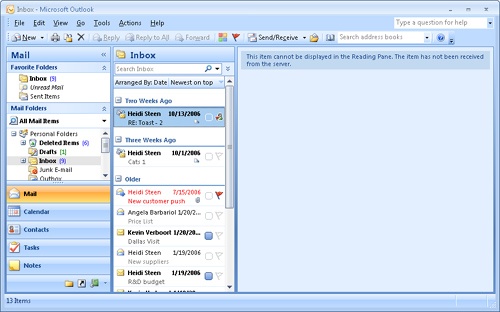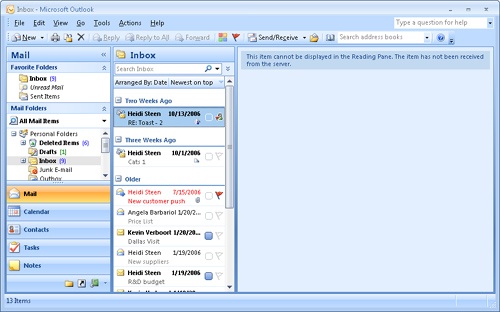The following sections explain the specific steps to follow as you perform various tasks with message headers through remote mail. You’ll learn how to download the headers, how to selectively mark them, and how to process them.
When you want to process messages selectively, you first download the message headers and then decide what action you want to perform with each message, based on its header. Downloading message headers for an account is easy. In Outlook 2007, choose Tools, Send/Receive, <Account> Only, Download Inbox Headers, where <Account> is the name of the account whose headers you want to process.
After you choose the Download Inbox Headers command, Outlook 2007 performs a send/receive operation but downloads only message headers from the specified account. If you want to save on connect charges, you can then disconnect from the server to review the headers and decide what to do with each message.
Outlook 2007 displays the downloaded message headers in the Inbox. Outlook 2007 displays an icon in the Header Status column to indicate that the message has not yet been downloaded, as shown in Figure 15-1. A message header that has not been marked for download shows a sheet of paper with the corner folded over. A message marked for download shows the same icon but with an arrow at the bottom.
After you download the headers, you can decide what to do with each message: retrieve it, download a copy, or delete it.
With a POP3 account, you can mark a message header to have Outlook 2007 retrieve the message, remove it from the server, and store it in your local store. With IMAP or HTTP mail accounts, you can mark a message header to have Outlook 2007 download the message, but those accounts continue to store the message on the server until you delete it.
To mark a message to be downloaded from the server to your local store, select the message header, right-click it, and choose Mark To Download Message(s). Alternatively, you can choose Tools, Send/Receive, Mark To Download Message(s).
In some cases, you might want to download a copy of a message but also leave the message on the server—for example, you might need to retrieve the same message from a different computer. To mark a message header to have Outlook 2007 retrieve a copy, select the message header, right-click it, and choose Mark To Download Message Copy. Alternatively, you can select the message header and choose Tools, Send/Receive, Mark To Download Message Copy. Outlook 2007 indicates in the Header Status column of the Inbox that the message is marked for download by changing the message icon accordingly, as shown in Figure 15-2.
You also can mark messages to be deleted from the server without downloading. You might do this for junk mail or messages with large attachments that you don’t need and don’t want choking your download session.
To mark a message for deletion, select the message header, right-click it, and choose Delete or press the Delete key. Outlook 2007 strikes through the message header and changes the download icon to indicate that the message will be deleted the next time you process messages, as shown in Figure 15-3.
As you work with message headers, you’ll occasionally change your mind after you’ve marked a message. In that case, you can unmark the message. Select the message header, right-click it, and then choose Unmark Selected Headers. Alternatively, you can choose Tools, Send/Receive, Unmark Selected Headers.
You also can unmark all message headers, clearing all pending actions. To do so, choose Tools, Send/Receive, Unmark All Messages.
After you’ve reviewed and marked the message headers, you can process the messages to apply the actions you’ve chosen. When you do so, for example, messages marked for download are downloaded to your system, and messages marked for deletion are deleted from the server.
To process all marked messages, choose Tools, Send/Receive, Process All Marked Headers. You can also choose Process Marked Headers In This Folder to process only the current folder or choose Tools, Send/Receive, Account Only, Process Marked Headers to process only a specific account. After you choose a command, Outlook 2007 connects and performs the specified actions, as shown in Figure 15-4.
Figure 15-4. Outlook 2007 displays this dialog box to indicate progress status for remote mail, as it does for other send/receive operations.
Troubleshooting
You can’t find the remote mail commands
As you work with remote mail, you’ll probably wish for an easier, faster way to access the remote mail commands. These commands are buried on the Tools menu, making it difficult to locate them quickly. Outlook 2007 also doesn’t provide a toolbar for remote mail commands. Fortunately, you can create your own toolbar if you find remote mail useful.
Follow these steps to create your own toolbar for remote mail:
In Outlook 2007, choose View, Toolbars, Customize (or right-click a toolbar and then choose Customize) to open the Customize dialog box. Click the Toolbars tab, shown in Figure 15-5.
Click New. Type the name Remote Mail in the New Toolbar dialog box, and then click OK. The new toolbar is listed on the Toolbar tab, and Outlook 2007 opens an empty toolbar.
In the Customize dialog box, click the Commands tab, and then in the Categories list, select Tools.
Drag the commands you want to include on the toolbar from the Commands list to the new toolbar. At a minimum, the following commands are useful:
Download Headers In This Folder
Mark To Download Message(s)
Mark To Download Message Copy
Delete (located in the Edit Categories list)
Unmark Selected Headers
Unmark All Headers
Process All Marked Headers
Process Marked Headers In This Folder





